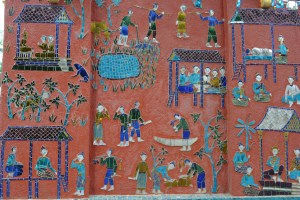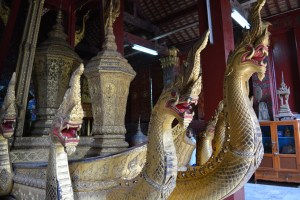0515 Reveille! Time to head out for the daily Almsgiving, an important ritual every morning in the life of a Buddhist monk.
Every male follower of Buddha becomes a monk for a week, a month, or longer during his life, but must be at least 10 years old. They shave their heads and wear orange robes. The personal reasons they join varies depending on age and situation. Young boys may be sent by their parents to learn how to be calm, to forgive, to practice self-discipline, and to respect others including their parents. In some cases, when a family is very poor and can’t afford to support a boy at home, they will send him to become a monk where he will be fed and go to school. Their curriculum is the same thing as a public school. A young man might become a monk prior to getting married in order to prepare for a successful relationship with his future wife. An older man might join to fulfill this duty after his children are grown and he has saved enough to provide for his wife while he is away. A retired man might join because he doesn’t want to live alone or without purpose and will remain a monk, perhaps teach until his death.
A monk’s daily routine is the same every day. Rise around 4:30 AM for prayers and chanting. At 5:30 AM they all grab their alms bowl, leave the temple, and walk to town. As they walk through town, they file by people who place small offerings in their alms bowl… a dollop of steamed rice, crackers, or other food. Whatever they collect is community food and is shared with all the monks when they return to the temple. Since the monks in this area are not allowed to cook food, families may choose to take their offering of a hot cooked dish directly to the temple. The food is separated and distributed. They only eat two meals a day: breakfast and lunch. There is no dinner meal. They spend the rest of the time in classes, chanting, meditating, or attending to personal hygiene, washing their clothes, and cleaning their sleeping area.

Ready and poised to offer food, but everyone is sleepy, and no coffee yet.

Roselie is wearing the traditional sash.

Monks collecting the Alms for the day.

Followers offering food.
We decided to participate in the alms giving. Oudone, our guide, arranged for each of us to have a bowl of cooked rice and a bowl of packaged crackers at a station on the sidewalk. We had to remove our shoes and wear a sash. We were instructed to sit or kneel. There is no touching of a monk, and our heads should be lower than the monks’ – hence the sitting on the little stools Oudone provided. At 6 AM a steady stream of about 150-250 monks came in single file down our street, opening the top of their alms bowl as they walked by so we could make our offering. Photos were not allowed when making the offering. After emptying our bowls, we put our shoes back on, and walked to another spot where we could photograph them on their return to the temple. A Buddhist family makes an offering every morning, all year-long. It was a great experience, but we couldn’t wait to grab that first cup of coffee.

Morning Market is open for business.
Following breakfast, we walked around the town. Shops and eateries of every variety tempts us to come in and buy. Next was a walk through the always present Morning Market to see what fresh products were featured today. Since most families do not have refrigerators, they shop for their daily meals every morning. Some items look great, some unknown, some I would not consider eating – such as beetles and cat. Several vendors offered fish and meat products… live frogs to prepare at home, pork sausages curing in the sun.

Gem stone artwork in the National Museum

Temple on the National Museum grounds.
After surviving the gauntlet of ‘delectables’ we made our way to the last Lao Royal Palace which is now a National Museum, housing the artifacts and possessions of the last royal family before communism took over. The walls were decorated with beautiful figures;designs made of gem stone and cut by Japanese artists.

Wat Xieng Thong

Temple’s Buddha and meditation room.

Funeral barge..
A short walk further to visit the Wat Xieng Thong,which was built-in the 16th century and survived several conflicts without damage. There are several structures on the grounds including the Chapel of the Standing Buddha, The Chapelle Rouge, a stoopa, and the Royal Funerary Chariot Hall. The Chariot hall houses the funeral carriage of King Vong who died in 1959.

Convolution of the Mekong and Kahn Rivers.

Relaxed, refreshed, and ready to go. Helen, Cristina, Roselie, Wenda, Andre, and Sue.

Sunset on the Mekong River
After a delicious Laotian lunch, we moved on to a boat ride on the Mekong river. (As a note about food. All of us thoroughly enjoyed Laos food and found it tastier than Thai food.) This was a very relaxing change of pace and gave us a chance to see the surrounding mountains – lush green with unusual peak formations – and watch the sunset.

Arriving at the family home for the Baci Ceremony.

Tying of strings on our wrists.

Delighted with the blessing and good wishes.
Our final experience of the day was to participate in a Baci ceremony at the home of a local family. The home was on a narrow dirt road in one of the typical neighborhoods. The Baci ceremony, dating back hundreds of years, is an important and meaningful component of Laotian culture. It means ‘calling of the soul.’ Its purpose is:
“To congratulate people who have overcome a serious problem for example, from sickness, from serious accident or a mother and her new-born baby.
To strengthen relationships or show solidarity between relatives, friends and colleagues or people who work together. It means to strengthen ties of friendship.
To bless people or wish them good luck. For example, people who are going to travel to another province or oversea for a long time. They always have a Baci ceremony to bless them and wish them success with their work, study and their lives.”

Traditional Laotian dance telling a story.
The ceremony begins with the prayer leader, an ex-monk, reciting a prayer and chanting in front of a decorative center piece. At the conclusion of the prayer he led his family members in tying white cotton strings on each of our wrists. These strings, which can be worn until they fall off, reportedly will bring us good health, good fortune, and safe travels. After the ritual, it’s time to move onto some refreshments and entertainment. We were offered a shot of their homemade moonshine (Wow – powerful stuff) made from rice, as well as homemade snacks. At this point five young women aged 10 to 16, came out in traditional Lao dress and performed a story with a graceful dance. It was very special. It was a perfect way to end the day.


Comments